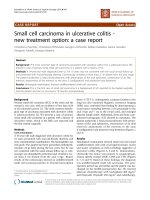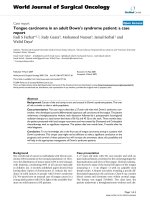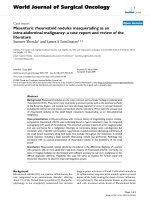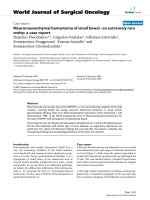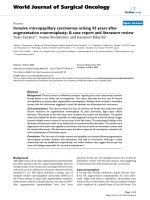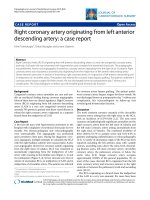báo cáo khoa học:" Bruxism secondary to brain injury treated with Botulinum toxin-A: a case report" ppt
Bạn đang xem bản rút gọn của tài liệu. Xem và tải ngay bản đầy đủ của tài liệu tại đây (246 KB, 3 trang )
BioMed Central
Page 1 of 3
(page number not for citation purposes)
Head & Face Medicine
Open Access
Case report
Bruxism secondary to brain injury treated with Botulinum toxin-A:
a case report
Mohammed El Maaytah*
1,2
, Waseem Jerjes
1
, Tahwinder Upile
1
,
Brian Swinson
1
, Colin Hopper
1
and Peter Ayliffe
1
Address:
1
Oral & Maxillofacial Surgery/Head & Neck Unit, University College London Hospitals, London, UK and
2
Division of Maxillofacial,
Diagnostic, Medical and Surgical Sciences, Eastman Dental Institute, 256 Gray's Inn Road, London WC1X 8LD, UK
Email: Mohammed El Maaytah* - ; Waseem Jerjes - ;
Tahwinder Upile - ; Brian Swinson - ; Colin Hopper - ;
Peter Ayliffe -
* Corresponding author
Abstract
We report a successful treatment of bruxism in a patient with anoxic brain injury using botulinum
toxin-A (BTX-A). On examination the mouth opening was 0 mm, no feeding was possible through
the mouth. Botulinum toxin was injected into the masseter and temporalis; great improvement in
trismus and bruxism was noted after 3 weeks. One further treatment improved the mouth opening
on the following week and the patient was discharged from our care to be reviewed when required.
Background
The term bruxism is derived from the Greek work
"brychein", which means "to grind or gnash the teeth".
The reported prevalence is 5 to 96% in adult populations
[1-5] and 15% in children [6]. Bruxism is often noted in
patients with altered states of consciousness, but its occur-
rence after brain injury is still unknown. Resolution of
bruxism is often associated with improvement in the level
of consciousness.
The appearance of bruxism has been closely linked to the
return of sleep-wake cycles and improvement of level of
consciousness in patients who were initially comatose [7].
To prevent dental wear, mouth guards, spasmolytic medi-
cations and relaxation therapy have been used with varia-
ble success.
In this report, we describe a successful treatment of brux-
ism in a patient with anoxic brain injury using botulinum
toxin-A (BTX-A).
Case report
A 26-year-old male suffering global ischemic/hypoxic
brain injury after attempted suicide by hanging was
admitted to University College London Hospitals
(UCLH) intensive care unit for resuscitation following res-
piratory arrest. The patient remained in coma for 12 days
with Glasgow Coma Scale (GCS) of 3–6. Gradual
improvement was noticed and the patient started showing
signs of alertness and increasing muscle tone of the upper
and lower limbs, however they were still in spasm (flexion
of upper limbs and extension of lowers). CT scans
revealed diffuse low attenuation change in the supratento-
rial compartment, loss of grey-white matter differentia-
tion and loss of sulcus pattern due to cerebral swelling; a
Published: 23 November 2006
Head & Face Medicine 2006, 2:41 doi:10.1186/1746-160X-2-41
Received: 04 July 2006
Accepted: 23 November 2006
This article is available from: />© 2006 El Maaytah et al; licensee BioMed Central Ltd.
This is an Open Access article distributed under the terms of the Creative Commons Attribution License ( />),
which permits unrestricted use, distribution, and reproduction in any medium, provided the original work is properly cited.
Head & Face Medicine 2006, 2:41 />Page 2 of 3
(page number not for citation purposes)
diagnosis of global ischemic/hypoxic brain injury was
then reached.
After one month, the patient responsiveness to touch and
voice increased, he responded to eye contact and
answered questions by yes/no and his GCS reached 15.
However, he continued to suffer muscle spasm, have no
control over his bladder or bowels and had difficulty in
speaking as well as feeding problems; he is currently
under multidisciplinary care.
The patient was then referred to the Department of Oral &
Maxillofacial Surgery (OMFS), UCLH suffering from tris-
mus and bruxism. Clinical examination revealed a mouth
opening of 0 mm; the patient was fed by a Percutaneous
Endoscopic Gastrostomy (PEG) tube as oral feeding was
impossible. Botulinum toxin was then suggested as a pos-
sible treatment for his problem.
The treatment (injections) was carried out in the follow-
ing visit. Botulinum toxin-A (Botox; Allergan Inc, Irvine,
CA) was injected into the right and left masseter and tem-
poralis muscles. One hundred units were reconstituted
with 2.5 mL of sterile preservative-free saline and drawn
up into an insulin syringe. The skin was cleansed with an
alcohol wipe, and the masseter muscle was palpated at its
insertion at the angle and body of the mandible. Two
injections of 4 Units (2 × 4 U) were given 1 cm superior to
the inferior border of the mandible and two other injec-
tions of 4 Units (2 × 4 U) were given 1 cm inferior to the
inferior border of the zygomatic arch. A fifth injection (1
× 4 U) was given in the centre of the masseter muscle.
Three more injections of 4 Units (3 × 4 U) were given 1 cm
inferior to the origin of the temporalis muscle. The proc-
ess was repeated on the contralateral side. (Figure 1)
Three weeks later, the patient was reviewed and had
shown a great improvement in his trismus with a mouth
opening of 15 mm, with no bruxism reported. There was
no erythema, swelling, or any clinical abnormality at the
injection sites.
Botox was injected again in the masseter and temporalis
muscles 2 weeks later. One week after the second treat-
ment, the patient showed signs of good recovery from tris-
mus and the mouth opening was 20 mm. The patient was
discharged from the OMFS care but continued to be under
the care of the multidisciplinary team.
Discussion
Bruxism after brain injury was first described by Pratap-
Chand and Gourie-Devi [8]; the group reported that brux-
ism in comatose patients appeared with the return of
sleep-wake cycle; they also suggested that bruxism can
occur at varying levels of consciousness and disappear
only after a significant improvement in consciousness.
Bruxism has been reportedly caused by, or associated
with, numerous conditions such as cranio-cervical dysto-
nia, post-anoxic brain damage, coma, cerebellar damage,
Huntington's disease, Rett's syndrome, Whipple's disease,
mental retardation and exposure to dopamine receptor-
blocking medications as well as selective serotonin re-
uptake inhibitors [9]. It has been reported that chewing
and teeth grinding can be a useful clinical sign to recog-
nize amphetamine addicts. However, the diagnosis and
management of bruxism in addicts have rarely been high-
lighted [9]. In the head and neck region, successful treat-
ment has been reported for temporomandibular joint
(TMJ) disorders, spasmodic torticollis, spastic dysphonia,
hemifacial spasm, masseter hypertrophy and "hereditary
trembling chin" or Satoyoshi's syndrome [10].
Injection sites in the masseter and temporalis musclesFigure 1
Injection sites in the masseter and temporalis muscles.
Publish with Bio Med Central and every
scientist can read your work free of charge
"BioMed Central will be the most significant development for
disseminating the results of biomedical research in our lifetime."
Sir Paul Nurse, Cancer Research UK
Your research papers will be:
available free of charge to the entire biomedical community
peer reviewed and published immediately upon acceptance
cited in PubMed and archived on PubMed Central
yours — you keep the copyright
Submit your manuscript here:
/>BioMedcentral
Head & Face Medicine 2006, 2:41 />Page 3 of 3
(page number not for citation purposes)
Management options are directed at protecting the teeth
by means of readjusting dental occlusion through a vari-
ety of intraoral mouth guards, placing stainless steel
crowns on teeth or dental extraction [11]. Unfortunately,
these interventions are mostly unsuccessful because of the
inability of the patients to cooperate with mouth guards
or because of the severity of the bruxism.
In 1990, Van Zandijcke and Marchau [12] reported
marked reduction in bruxism after injection of botulinum
toxin-A into the masseter and temporalis muscles in a
patient recovering from a coma.
Muscle weakness (facial weakness) is a known complica-
tion for the treatment in this region due to the diffusion
of solution across the facial planes [13]; this was not
reported by our patient.
Botulinum toxin injection in the masseter muscles is an
effective and safe means of intervention in cases of severe
post-traumatic bruxism. It may be the only practical inter-
vention available during the period of severe jaw clench-
ing seen after brain injury when the patient is unable to
cooperate. Factors that may affect the clinical response
include dose, size of the muscles, severity of bruxism and
careful identification of the muscles involved.
Trismus after acute cerebrovascular accident (CVA) in
adults is a rare complication; however, it was reported by
Spillane et al. [14] occurring in an adolescent male; the
patient was treated with escalating doses of BTX-A and
excellent results were achieved after the third set of injec-
tions. The dose used for the third set of injections, given
approximately 20 months after CVA, was 300 U total.
Recently, Kadyan et al. achieved excellent results using
only 10 U of BTX-A in the temporalis muscle [15-17].
We were able to relieve the bruxism and trismus by using
20 U of BTX-A in the masseter muscle per side and 12 U
of BTX-A in the temporalis muscle per side; further
improvement was noticed after carrying out the treatment
one more time.
References
1. Choi YS, Choung PH, Moon HS, Kim SG: Temporomandibular
Disorders in 19-Year-Old Korean Men. J Oral Maxillofac Surg
2002, 60:797-803.
2. Thompson BA, Blount BW, Krumholz TS: Treatment approaches
to bruxism. Am Fam Physician 1994, 49:1617-22.
3. Solberg WK, Woo MW, Houston JG: Prevalence of mandibular
dysfunction in young adults. J Am Dent Assoc 1979, 98:25-34.
4. Glaros AG: Incidence of diurnal and nocturnal bruxism. J Pros-
thet Dent 1981, 45:545-9.
5. Pavone BW: Bruxism and its effect on the natural teeth. J Pros-
thet Dent 1985, 53:692-6.
6. Schneider PE, Peterson J: Oral habits: consideration in manage-
ment. Pediatr Clin North Am 1982, 29:523-46.
7. Pratap-Chand R, Gourie-Devi M: Bruxism, its significance in
coma. Clin Neurol Neurosurg 1985, 87:113-7.
8. Pratap-Chand R, Gourie-Devi M: Bruxism: Its significance in
coma. Clin Neurol Neurosurg 1985, 87:113.
9. See S-J, Tan E-K: Severe amphetamine-induced bruxism: treat-
ment with botulinum toxin. Acta Neurol Scand 2003,
107:161-163.
10. Pidcock FS, Wise JM, Christensen JR: Treatment of severe post-
traumatic bruxism with botulinum toxin-A: case report. J
Oral Maxillofac Surg 2002, 60(1):115-7.
11. Attanasio R: An overview of bruxism and its management.
Dent Clin North Am 1997, 41:229.
12. Van Zandijcke M, Marchau MM: Treatment of bruxism with bot-
ulinum toxin injections. J Neurol Neurosurg Psychiatry 1990,
53:530.
13. Shaari CM: Quantifying the spread of botulinum toxin through
muscle fascia. Laryngoscope 1991, 101:960.
14. Spillane KS, Shelton JE, Hasty MF: Stroke-induced trismus in a
pediatric patient long-term resolution with botulinum toxin
A. Am J Phys Med Rehabil 2003, 82:485-488.
15. Ivanhoe CB, Lai JM, Francisco GE: Bruxism after brain injury suc-
cessful treatment with botulinum toxin-A. Arch Phys Med Reha-
bil 1997, 78:1272-1273.
16. Tan EK, Jankovic J: Treating severe bruxism with botulinum
toxin. J Am Dent Assoc 2000, 131:211-216.
17. Winterholler MG, Heckmann JG, Hecht M, Erbguth FJ: Recurrent
trismus and stridor in an ALS patient successful treatment
with botulinum toxin. Neurology 2002, 58:502-503.

